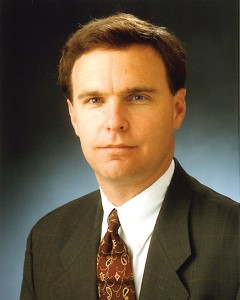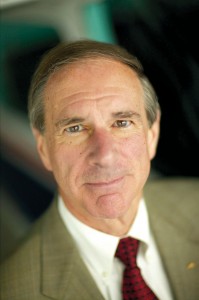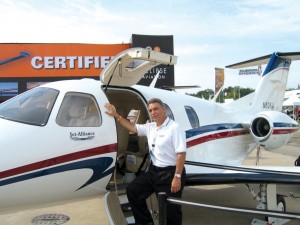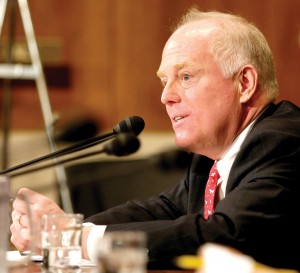By Karen Di Piazza
To say hostilities continue to mount on both sides of the user-fee debate is understated. It’s a war.
The general aviation industry vehemently opposes the Air Transport Association’s proposal to shift $2 billion of the airlines’ costs onto the GA business aircraft segment, through implementation of user fees, to support the air traffic control system. User fees, if imposed, would jettison current fuel taxes GA business aircraft pay into the Airport and Airway Trust Fund. GA trade groups say the ATA wants to have a separate “rate” board, removing Congress’ oversight, and control the air traffic control system, which would give airlines a monopoly on controlling the nation’s airspace.

Ed Bolen, president and CEO of the National Business Aviation Association, warns the GA community that user fees are a form of a new tax. He says if the Air Transport Association’s use-fee scheme isn’t defeated, GA will be taxed right out of the system.
The ATA, the lobbying association for the airlines, believes that Congress can no longer effectively manage the ATC system. The association says that although ticket, fuel and waybill taxes pass to the Airport and Airway Trust Fund, and the general public funds the General Fund, Congress has the final word. As such, the ATA says that each year Congress reduces the GF contribution, and now the ATC system is suffering. Airlines argue that they are subsidizing business GA’s use of the airspace; they’re demanding all jets, no matter what type, pay the same user fee.
Time is running out. Both the Airport and Airway Trust Fund and the Federal Aviation Administration’s reauthorization bill expire Sept. 30, 2007, at which time the FAA’s ability to appropriate funds ends. FAA Administrator Marion Blakey has stated that a new funding source is critical. In February of this year, she told Congress the FAA’s funding proposal had been sent to the Office of Management and Budget for review. It was to be released in the spring, but that didn’t happen.
Now the FAA funding proposal is on the backburner, with GA and the airlines left simmering over user fees. Congress won’t hear this issue until next year, but it’s not known when. GA industry leaders fear the FAA will wait until the last minute to provide its proposal, and then file for an extension past the September 2007 deadline, escalating the user-fee war.
GA industry leaders say the congressional elections of November 2006 could play a role in the FAA stalling to deliver its funding proposal. They also note that the president’s budget for fiscal year 2008 is due to Congress Feb. 5, 2007, and that Blakey’s first term expires Sept. 13, 2007. That might further postpone the FAA’s funding proposal, depending upon whether she resigns or is reappointed.
Under the current Airport and Airway Trust Fund, GA pays set prices for fuel. The National Air Transportation Association’s website states that GA jet fuel is being taxed at 21.9 cents per gallon, and aviation gasoline, used for piston aircraft, at 19.4 cpg.

Jack Pelton, chairman, president and CEO of Cessna Aircraft Co., and chairman of the General Aviation Manufacturers Association, says the airlines are looking at the upcoming FAA reauthorization bill as a way to shift their costs.
According to the ATA’s website, all airlines pay a 7.5 percent ticket tax, a fee of $3.20 per passenger for each flight segment flown, a fee of $14.10 per passenger for each international departure or arrival, and a fuel tax of 4.3 cents per gallon.
All those taxes and fees are passed on to passengers. Ten years ago, the airline ticket tax was 10 percent, but it was lowered after legacy airlines went after low-cost carrier Southwest Airlines, trying to impose user fees in an attempt to put SA out of business.
Today, through the ATA, airlines are united for the first time in their determination to impose user fees onto GA. The GA industry says that although passengers pay ticket taxes, the airlines earn interest on the money collected, before being required to remit it to the federal government, which funds the trust fund.
In the early stages of the user-fee debate, NATA’s President James K. Coyne said the ATA omitted the Aircraft Owners and Pilots Association and the Experimental Aircraft Association from its user-fee scheme in an effort to divide the GA community. AOPA, whose 408,000 members fly mostly piston and turboprop aircraft, and EAA—representing the antique, warbird, aerobatic aircraft, ultralights, helicopters and contemporary manufactured aircraft—have joined with NATA, along with the National Business Aviation Association and the General Aviation Manufacturers Association, to oppose user fees.
GA events have become user-fee political forums
During this year’s EAA AirVenture in Oshkosh, Wis., large crowds listened to two different political forums. Blakey explained why the FAA still has no funding proposal, while EAA President Tom Poberezny hosted a user-fee panel. The panel included NBAA President Ed Bolen; Jack Pelton, chairman and CEO of Cessna Aircraft Co. and chairman of GAMA; Phil Boyer, president of AOPA; Pete Bunce, GAMA president; and Alan Klapmeier, Cirrus Design cofounder and CEO.
During a Q&A session after Blakey’s speech, someone from the audience asked, “Will GA get a fair shake on the FAA’s user-fee proposal?”
“There seems to be a cozy relationship between the FAA and the ATA—to the extent that one of your senior staffers will wind up on their payroll,” that person continued.
Blakey responded that people would also say the FAA has a very close relationship with the GA community.
“We certainly do with EAA and AOPA,” she said. “We try to work very closely with the associations that represent the aviation community. But it’s not a question of a cozy relationship. Obviously, people leave the FAA and they go to work for all sorts of places.”
It was during that Q&A session that Blakey stated she still had no funding proposal.

Phil Boyer, president of the Aircraft Owners and Pilots Association, says going after GA as the funding mechanism for the ATC system isn’t the answer. AOPA’s 408,000-plus members will fight user fees being imposed onto GA.
“For the last year and a half, I’ve worked very closely with the staff here to try to come up with a good strong proposal, but I felt we didn’t have a consensus of what that proposal would look like,” she said. “I felt we needed to work more with all of you, and we went back to the table to discuss what can work. And that’s where we are.”
GA trade groups are suspicious about Blakey’s comment regarding where the FAA is presently: without a funding proposal in place. In 2005, right after Congress approved FAA funding for FY 2006, Blakey immediately started campaigning for a new funding approach, saying the FAA needs a constant, stable revenue stream that’s related to the actual cost of the services it provides.
While talking about airlines wanting to control the system, Pelton says they haven’t been able to run their own businesses. He said that one by one, “airlines are walking away from their pension fund obligations.”
“The airlines have passed that on to all of us as taxpayers,” he said. “I don’t view that as being a responsible business.”
Pelton said the airlines are looking at the upcoming FAA reauthorization bill as a window of opportunity.
“A window for cost shifting—not cost sharing—and not being responsible for dealing with its own businesses,” he said. “If you look at the airlines’ hub-and-spoke system, where the fundamental costs are in the system, typically, GA uses airports that aren’t part of that system.”
Pelton asserts that people are moving to GA and away from paying premiums to airlines for air travel, for “quite obvious reasons.”
“Their service is terrible; they’re charging for everything—from meals to services on the airplane,” he said. “And the ability to get where you need to go is becoming less and less.”
Bolen said that in March, when the ATA launched Smart Skies, its blueprint for modernization of the ATC system, it became clear that “airlines want to pay less and control more.”
“User fees are a very immediate, very serious threat,” he warned. “Whether it’s a 555-passenger A380 or a Malibu Meridian aircraft with three passengers, they want GA to pay the same user fee. To them, it’s all the same—a bunch of metal flying through the air.”
He adds that this user-fee fight is fundamentally different in that GA is the main target, “compared to 10 years ago, when only six major airlines were trying to put low-cost-carrier Southwest Airlines out of business.” He says user fees are a form of a new tax and ATA will tax users right out of the system.

Randall Sanada, cofounder and chairman of California-based Jet-Alliance, Inc., who will take delivery of the first Eclipse very light jet, says imposition of user fees will denigrate safety.
Is there, perhaps, a middle-of-the-road approach to user fees? Robert Crandall, the former CEO of American Airlines, who has raised about $14 million for Pogo, his air-taxi charter company, has an idea. Instead of the airlines and GA warring over who should pay, and how much should be paid for ATC services, he says the general public should pay for a major share of the cost of maintaining the aviation infrastructure. Why?
“They benefit from aviation in many forms,” he explained.
But Blakey said the FAA isn’t interested in the idea of raising passenger ticket taxes, which would bring in more revenue to support the ATC system. Other aviation leaders have also thought raising the ticket tax would help, especially given the fact that Blakey has repeatedly said part of the FAA’s funding woes are directly tied to shrinking funds coming from airlines’ passenger ticket taxes, as more LCCs offer cheaper fares.
AOPA’s Boyer says going after GA as the funding mechanism for the ATC system isn’t the answer.
“It’s a marginal cost adding GA into the system; it doesn’t even rise above the noise level,” he said. “When GA was banned from Reagan National Airport, the cost to run the ATC system didn’t decrease at all.”
He also pointed out the flaw in ATA’s user-fee plan, which would exclude piston-powered aircraft that use avgas, saying it ignores the future.
“Today’s GA planes are already in transition from avgas-fueled, piston-powered engines to lightweight, lower-powered turbines,” he explained. “In the lifespan of the next-generation ATC system, a significant portion of the GA fleet could be jet-fueled turbines.”
Watching blips go by
Bolen says that according to the airlines, all IFR aircraft on radar blips are the same. He argues that it’s the airlines’ hub-and-spoke model that’s creating the burden on ATC. One airline, for instance, “schedules 50 planes into a single airport within a 15-minute window.” Not so with GA.
James C. May, president and CEO of the ATA, argues that business jets pose the same kind of challenges in the maintenance of air safety as commercial jets.
“They both represent an equal cost burden in ATC services,” he said. “Tracked on radar, on satellite, and then transferred to a computer screen, ‘a blip is a blip.’ It’s volume that drives system costs today, and will drive it tomorrow, even more. Controllers do the same job for a Boeing 747 or a business jet. All users of the ATC system, both the airlines and corporate jets flying IFR, should pay the same user fee.”

Eric Byer, National Air Transportation Association VP of government and industry affairs, says it’s not fair for GA aircraft that don’t impose any real costs on a system to pay user fees.
Eric Byer, NATA’s VP of government and industry affairs, says it’s not fair for aircraft that don’t impose any real costs on a system to pay user fees. He says the ATC system is designed to handle the airlines at rush hour; to impose user fees onto the GA segment would be subsidizing the airlines, so GA would be overpaying to use ATC services.
“It’s a false premise that a blip is a blip,” he said. “A 747 moving through the New York TRACON late in the afternoon into Newark imposes a far greater burden on the ATC system than does a turboprop flying into Albuquerque at midnight. To suggest otherwise defies common sense.”
May says business jets represent 18 percent of flights but only pay five percent of FAA fees, whereas airlines represent two-thirds of flights and pay more than 90 percent of fees. But In August, the ATA’s website stated that its airline members transport more than “90 percent” of all U.S. airline passenger and cargo traffic
Milking VLJs for $2 billion
GA leaders believe that the ATA is looking at VLJs as the means to extract $2 billion in user fees to support the ATC system and make up for airlines’ shortfalls. In April, during his speech to the International Aviation Club in Washington D.C., May quoted astonishing VLJ numbers.
“The current ATC system is nearing overload,” he said. “Looking out over the next decade, the FAA’s workload, according to its own numbers, projects a rise of 36 percent, from 45,100 flights per day to 61,400 flights per day. That’s before completely factoring in the potential for an additional 20,000 VLJ flights!”
He said that 50 percent of those 20,000 VLJs “will use the same markets as those big commercial airports,” based on a study conducted by MIT he quoted.
Not even Vern Raburn, CEO and president of Eclipse Aviation, which is manufacturing the Eclipse 500, has predicted such optimistic numbers. VLJ numbers are all over the place. Recently, the FAA forecast 5,000 VLJs will enter the system by 2017, and about 1,500 will be used in the air-taxi charter segment.
Although the airlines claim that VLJs will add a significant burden to the ATC system, Pelton argues that VLJs are intended to relieve the congestion from the existing 35 hub airports. They won’t further burden the system or add cost to the airlines.

President James K. Coyne of the National Air Transportation Association says a user-fee plan, if imposed, could end up where GA pays fuel excise taxes and both airport and air traffic control user fees, like it did in Canada.
“But this is some of the rhetoric they’re trying to push towards GA,” he said. “I think another reality we need to face is that the airlines are pushing the FAA to fund airport infrastructure to support the A380. There’s going to be a funding requirement within the U.S. exceeding $1 billion at key hub airports to support the A380.”
He says paying for that shouldn’t be GA’s burden. He also believes that the airlines’ entire motivation with user fees is to avoid running their businesses the way GA has to— “profitably and effectively.”
Inevitable user fees and Congress hampering FAA’s job?
Robert W. Poole Jr., director of transportation and cofounder of the Reason Foundation, a Los Angeles-based think tank that publishes Reason Magazine, says without fundamental change, the ATC system will begin running out of capacity this decade.
“Within 20 years, untenable delays will force cutbacks in both the airline and the business jet segments of aviation. It’s inevitable,” says Poole, the author of a new 40-page study, “Business Jets and ATC User Fees: Taking a Closer Look.”
He said business aircraft operators should seriously rethink opposition to user fees, forecasting potential cost-savings and network improvements. In his study, he used 15 commonly used business jets ranging from the Boeing Business Jet to Eclipse’s VLJ. He compared existing aviation taxes using several hypothetical user-fee ATC scenarios.
“Charter and fractional business jet operators would pay one-third less than the aviation taxes they currently pay, if ATC shifted to a user-fee system based on a weight-distance formula like that of Nav Canada,” he said. “Fractionals and charters pay four to five times as much as corporate-owned jets for identical services in today’s system. The identical plane can pay three greatly different amounts for the same ATC services, depending on who owns it.”
Opponents of user fees point out that in Canada, both GA piston-powered aircraft and business aircraft pay user fees plus excise taxes. But Poole says the business jet community “should support fundamental reform and modernization of the ATC system, to prevent its imminent breakdown and to permit the timely doubling of capacity that they need as much as the airlines.”

Robert W. Poole Jr., director of transportation and cofounder of the Reason Foundation, said business aircraft operators should seriously rethink opposition to user fees. He forecast potential cost-savings and network improvements.
“If the shift to a $20 billion next-generation ATC system isn’t made in a timely fashion—and currently there’s no revenue stream to pay for that investment—the system will likely be forced to ration airspace,” he said. “As a result, families would pay dramatically higher airline ticket prices; the burgeoning GA business industry would be hit hard by rising costs and reduced access to runways and airspace.”
Poole says both NATA and the NBAA oppose ATC user fees largely out of concern that they will greatly increase the cost of business aviation. He urges these organizations, as well as others that oppose user fees, to read the study, as he believes user fees of some type will “free” the system.
Both NATA and the NBAA gave thought to Poole’s study.
“Before we can talk about financing a future ATC system, we need to agree on what that future ATC system is going to be,” Byer said. “It seems that the cart is way out in front of the horse.”
He said a good first step would be to respect the critical role that charter, fractional and business aircraft operators play in the system and in our nation’s economy.
“While the Reason Foundation’s report raises some interesting points, it’s in the national interest to allow all these key players to have a voice on par with the airlines at the ATC decision-making table,” he said. “That’s not there now. With a fair and balanced approach in place, we’d be eager to talk about how best to fund the system.”
Bolen dismissed Poole’s study by saying it wouldn’t have much impact on the user-fee debate, and that Poole has always had a clear mission to promote government privatization efforts.
“This study is another example of that,” he said.
May says that as for overseeing ATC, Congress will not hesitate to insert itself into the political mix, particularly when program cuts and consolidations impact constituents back home.
“The recent TRACON at Palm Beach and Miami International Airport is a perfect example of what shouldn’t happen,” he said.
Jonathan Howe, a former president of the NBAA and head of the Airports Council International, says the FAA hasn’t had and doesn’t have the political clout to do what needs to be done: “shut down inefficient ATC facilities!”
“Twenty years ago, the FAA had capabilities to use a remote-radar system that should have shut down the San Juan, Puerto Rico facility,” says Howe, who held high-level positions with the FAA for more than 20 years. “I was there. There was so much traffic between Puerto Rico and Miami that the Miami facility was the first to utilize a satellite-based system for long-range ATC.”

James C. May, president and CEO of the Air Transport Association, argues that business jets pose the same kind of challenges in the maintenance of air safety as commercial jets. He says both the airlines and corporate jets flying IFR should pay the same.
He said that before he left the FAA, he could stand at a controller position in Miami and “watch” all the air traffic in San Juan.
“San Juan wasn’t shut down,” he said. “Repeat that situation throughout the country—you’ll start to understand the problem, the fight over user fees to fund the ATC system.”
Howe says there are too many ATC facilities in this country and that the biggest expense to the ATC system is the handling of aircraft by radar.
“The antiquated ATC system—basically, AM radio—requires ‘each controller’ to talk to individual pilots flying IFR,” he explained. “Modern equipment would reduce the number of controllers needed for each user of the system. So, of course, controllers have a vested interest in maintaining and increasing staffing, with extraordinarily high salaries and benefits. And politicians don’t want jobs taken out of their districts, so when the FAA tries to close a facility that isn’t necessary, everyone goes screaming to Congress. Then, Congress starts screaming to the FAA.”
Howe says that if logic prevailed, all en-route air traffic in the U.S. could be controlled out of four or five ATC facilities.
“Germany, one of many countries that have a user-fee system, manages its entire air traffic using one ATC center,” he said. “The U.S. has far more air traffic than does Germany, but the number of facilities you need isn’t a function of the amount of traffic. Within a local facility you’d still have to separate traffic, in terms of workload, but today’s radar-based approach controls could be centralized. All major towers have a radar approach system. For instance, you don’t need people physically in Atlanta, Ga., to ‘control’ the radar traffic; I’m not talking about visual responsibilities that a tower has.”
Bolen, though, warns that the ATA will do everything possible to get Congress out of the way when it comes to managing the ATC system. What happened in Canada is a perfect example of a user-fee system gone bad, where airlines are off the hook, but GA is paying more now than ever before.
Canada’s private ATC system is run by Nav Canada. John Crichton, Nav Canada’s president and CEO, wrote a letter to the minister of finance, complaining about how the user-fee system is hurting its GA community. When user fees were implemented, airline passenger taxes were eliminated completely. Now GA is paying fuel excise taxes, ATC and airport user fees. Plus, revenues that GA is now paying from fuel excise taxes don’t pass to Nav Canada to run the country’s all-user-fee supported ATC system. If Congress was removed as the board of directors overseeing ATC funding, the same thing that happened in Canada could happen in the U.S.
This is one of many reasons why Bolen and other leaders of GA trade groups say that if user fees are imposed, it will be “the death of GA in the U.S.”

Jonathan Howe, a former president of the National Business Aviation Association and head of the Airports Council International, says the FAA doesn’t have the political clout to do what needs to be done: “shut down inefficient ATC facilities!”
“The ATA believes Congress is part of the problem,” Bolen said. “The GA community understands that Congress is needed to ensure that communities across the country continue to have access to the strongest aviation system in the world.”
Coyne said user-fee systems in Canada and Europe aren’t very good.
“As the mechanism becomes unstable in economic downturns, it makes government bailouts necessary, or fees must be increased,” he said.
Voices from other GA stakeholders
If a user-fee system were imposed, worries Gretchen Jahn, CEO of Mooney Airplane Company, it would create more “non-value-added jobs.”
“Salaries paid to collect user fees will consume all the additional monies above the fees that would have come from a fuel tax,” she said. “Instead, we need additional FAA inspectors to reduce the cost and time for certification of new aircraft.”
Randall Sanada, cofounder and chairman of California-based Jet-Alliance, Inc., a fractional-share service administrator, opposes user fees for several reasons.
“When a GA pilot flies under visual flight rules, it’s generally not mandatory that they be in contact with ATC, but it’s much safer for everyone in the sky if they do request flight following from ATC,” says Sanada, who is waiting delivery of the very first Eclipse 500 VLJ (tail number N508JA). “If user fees are imposed, there may be a tendency for some to fly without flight following. I believe that imposition of user fees will denigrate safety because some pilots will choose not to use the services.”
Sanada believes that the creation of a new government or private bureaucracy will result in an added expense to all.
“The time and expense of tracking, calculating and exacting these fees on users will be substantial,” he said. “This is in comparison to the existing tax structure, which has been in place for decades, where there’s little cost to collect current excise taxes. Even if the FAA is in need of additional revenue, the creation of a new system of user fees isn’t the answer.”
Jim Betlyon, chairman and CEO of CharterX Corp, daily talks to operators, fractional providers and air charter brokers. He says user fees will never defeat what GA is really about.
“On-demand travel for business passengers has become a way of life; providing users of the private air transportation system real-time options is a way of life,” says Betlyon. “The airlines haven’t understood this concept—a concept growing stronger each day; it won’t be undermined by the airlines trying to impose a user-fee system onto GA.”
Bob Brewster, corporate administrator of Dayton, Fla.-based Lynch Corporate Services, a fixed based operation, believes the airlines have gone mad.
“The airlines have forgotten what business they’re in—the transportation of people!” he says. “There are 5,287 GA airports in the U.S.; only 542 airports have commercial operations. The airlines are only using about 10 percent of airports, which is why private aviation can take over providing air transportation.”
He said that airlines are upset because they can’t compete unless user fees come into play.
“Airlines are desperate,” he said. “They’re pointing fingers at GA, whining, ‘It’s everybody else’s fault.’ They expect a user-fee bailout. User fees aren’t meant to pay for the ATC system; airlines need user fees to cover the high-overhead costs that they’ve talked themselves into maintaining all these years—terminals, huge airline infrastructures. We’re seeing a metamorphosis of an industry where scheduled carriers are going to have to downsize and merge.”

Time is running out. Marion Blakey, Federal Aviation Administration administrator, says she still has no funding proposal. Both the Airport and Airway Trust Fund and the FAA’s reauthorization bill expire Sept. 30, 2007.
Greg Herrick, publisher of AircraftOwner magazine, strongly believes that the GA community needs a “sounding alarm,” on the user-fee issue, to realize just how serious this threat really is.
“I feel we must all take collective and cooperative action to fight the user-fee battle,” he said. “If we don’t fight the ATA’s user-fee proposal, this is a battle we may all lose in the end. By banding together, we could counter the ATA’s propaganda and misinformation.
Pamela Phillips, manager of Tri-City Aviation, the only GA facility at Tri-Cities Regional Airport in Blountville, Tenn., says her FBO is “subsidizing the airlines.”
“We were told we had to pay more money because United left July 2001; now the airport is offering United a $250,000 incentive package,” she quipped.
All totaled, TCRA will get 10 cents per gallon of GA fuel—an extra four cents per gallon over the previous price—plus $23,000 a month for a rent/land lease from the FBO. Phillips is angry that the incentive package, intended to woo United back, includes $150,000 to promote its flights, plus waived landing fees and terminal rents for six months.
“This goes to show that GA users are paying for airline services they don’t benefit from; we’re servicing about 60 corporate flights a day,” she said. “There’s no free ride for us!”
Linear Air President and CEO William Herp has been operating a successful Massachusetts-based Part 135 air-taxi business with a fleet of four turboprop Cessna Caravans, and has ordered 30 Eclipse 500 VLJs. He says that, speaking as an operator, maybe user fees aren’t so bad.
“If you’re operating commercially, then you’re required to collect the excise taxes for your customers and send it to the IRS, to the United States Treasury,” he said. “I’ve seen a couple of the calculations done based upon a couple of the different user-fee proposals. Based upon our types of flying, I think it’s going to end up being about the same amount. Ultimately, it’s not a cost for us, really; it’s something that we collect from the consumer, like a sales tax.”
Herp says for his operation, user fees would be passed on to passengers, so it’s a question of what’s the most equitable way in which to fund the ATC system based upon the use of the system.
Meanwhile, GA trade groups will continue to oppose user fees, as they agree user fees imposed onto any GA segment in the U.S. isn’t equitable.











